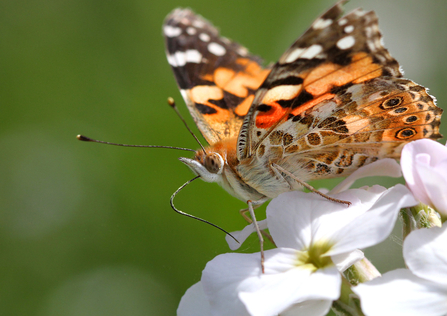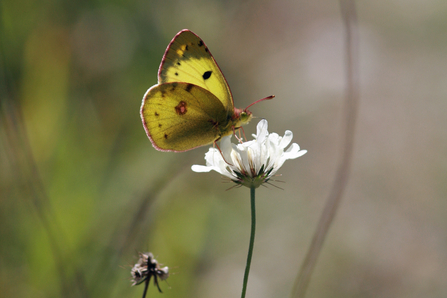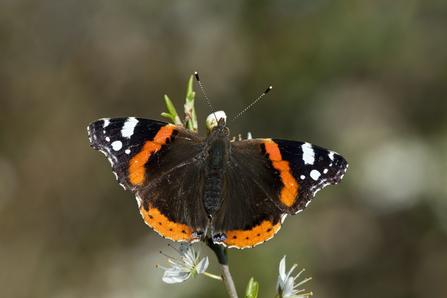Many of us will perhaps be travelling far fewer miles than we had anticipated this summer but that is not the case in the natural world, with vast numbers of insects travelling thousands of miles to feed and breed. Using radar data, migratory ecologists have revealed that 3.5 trillion insects with a combined biomass of 3200 tonnes (270 London buses) fly over southern England each summer. Here we take a look at some of the winged wanderers from the butterfly world undertaking mammoth missions.

Painted lady © Jon Hawkins
Long-distance Ladies
The endurance athletes of the butterfly world, the tenacious painted ladies make the longest distance migration of any insect – a 9000-mile round trip. Beginning in early spring, as the days start to lengthen, painted ladies in Central Africa will start their epic trip northwards across the Sahara Desert before reaching North Africa and southern Europe. Further generations will then continue the journey across Europe before reaching British shores; incredibly, they simply use the sun as a compass and rely on their genes to show them the way – a sort of innate sat nav if you will.
Although their distribution varies from year to year, once here, the painted ladies spread far and wide, even being found breeding as far north as Orkney and Shetland. A favoured foodplant of both adult butterflies and their larvae are thistles and indeed an early name for this species was ‘The Thistle’.
Until recently, the fate of these plucky travellers was not known, as although their triumphant arrival was witnessed by many, their departure, or possible demise, was shrouded in mystery. Only when scientists were able to use vertical-looking radar equipment did they discover that, having gorged on bountiful British blooms, and triggered by an autumnal shortening of the days, the painted ladies soar homeward at altitudes of 500-1200m, where faster winds help propel them forth at speeds of up to 30mph.
Every ten years or so, the painted ladies’ migration can be spectacular, with swarms arriving throughout the summer; the last exceptional year was 2009 with radars tracking up to 11 million painted lady butterflies arriving on our shores over just one weekend in late May! Painted lady records for 2020 have been lower than average – perhaps, like the rest of us they are staying close to home – but there is still a chance of seeing one up until October so keep an eye out for these black-and-white-splashed, tawny beauties in gardens and green spaces.

Clouded yellow © Mark Joy
Clouds of Yellow
A chlorinous haze drifting over the Channel was feared by World War 2 military observers to be a poisonous gas attack…it was in fact a mass migration of clouded yellow butterflies. These powerful-flighted, marigold-hued migrants make their marathon journey here from North Africa and southern Europe each summer and like the painted ladies, in certain years, the numbers reaching our shores are colossal.

Clouded yellow © Mark Joy
Some believe their name derive from the migrating ‘clouds’ however it is more widely thought to refer to the dark borders of their wings which are rarely seen thanks to this butterfly’s preference for firmly closing them upon landing. Alternative names refer to their rich, butterscotchy colouring – saffron butterfly, clouded orange and clouded saffron – indeed, its species name, croceus, is Latin for ‘saffron’. They are especially fond of chalk grassland habitats and can be seen flying at Hutchinson’s Bank nature reserve, Croydon now and throughout late summer .

Red admiral © Guy Edwardes
Admirable Admirals
With its velvety black wings striped with fiery crimson, the red admiral is one of our most iconic butterflies; in France they are fittingly known as Le Vulcain after Vulcan, the Roman god of fire and volcanoes. Like the clouded yellows, most individuals migrate here from North Africa and continental Europe, with the first to arrive in early spring when they will mate, and females will then lay their eggs, mainly on stinging nettles. Although some individuals now survive the harsh British winter, and can therefore be considered resident, most migrate south once more. Numbers fluctuate year on year and it is still not understood why some will decide to remain here throughout the colder months while others leave, but it is thought that the milder winter temperatures caused by climate change will see an increase in the resident population. A frequent visitor to gardens, you stand a good chance of spotting one feeding on buddleia or on fallen, rotting fruit.
The interest and excitement surrounding migrating butterflies shows no signs of abating with enthusiasts being positively giddy at the possible prospect of a 60th British butterfly in the form of the southern small white. This diminutive relative of the small white has been sidling its way across northern Europe in recent years and it’s hoped that it will take up residence – eyes to the skies to be the first to record one!
For this summer at least, I shall be living vicariously through butterflies without borders, and for each one I spot flitting past, will take a moment to reflect on its journey – across my local green space? Across London? Or perhaps, much, much further.
London Wildlife Trust has partnered with the Natural History Museum and Butterfly Conservation on the Brilliant Butterflies project which is creating and restoring butterfly habitat across South Croydon and Bromley, thanks to players of the People’s Postcode Lottery – find out more here:
https://www.wildlondon.org.uk/brilliant-butterflies

